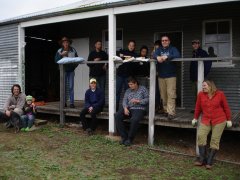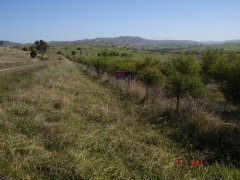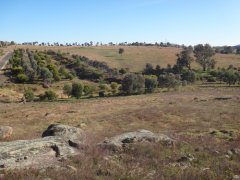This project allowed four adjoining members of the Hovells Creek Landcare Group to better manage their vegetation, soil and water resources along their frontage to the Lachlan River below Wyangala Dam. It aimed to reduce silt loads in the Lachlan River through stock-removal, strategic fencing and revegetation, to facilitate recovery from (current) drought, and to facilitate better natural resource management during future droughts, while at the same time maintaining the viability of family farm enterprises.
Through this project
- 8 km of environmentally sensitive frontage to the Lachlan River, eroded watercourses leading into the river were fenced,
- 14 new stock watering points, 2.5 km of water pipe, four water tanks and two solar pumps were installed,
- 8,000 endemic trees and shrubs were planted to revegetate some of 8 hectare of eroded watercourse, and
- Rabbit warrens were gassed and ripped.
The trees / shrubs were planted in July and August 2006, which was an extremely dry year. The calendar year received 280mm and the February 2006 to January 2007 received just 218mm, the driest 12 months in our records. Average rainfall is 624mm. Despite this, the deep ripping and adequate weed control led to excellent establishment of about half of the plants. Some locations had better results, but closer to the Lachlan River the failure rates were higher. All dead plants were replaced with shrubs in 2007 and trees in 2008. The treelots have matured well and by the end of the 2009/2010 summer it was impossible to ride a bike between the rows. The most suited species are now growing from their own seeds, offering us some hope for sustainability through self-replacement.
The tree / shrub planting was supported by Conservation Volunteers Australia (http://www.conservationvolunteers.com.au), including volunteers from Korea, Germany and England.
As a result of this project, we have seen a rapid recovery of fresh water springs, reduced erosion, recovery of native vegetation along our watercourses, and an increase in native bird species. It has allowed improved grazing management of native pastures, encouraging their spread and persistence, and an increase in shade and shelter for stock, reducing their current effects around isolated trees.
This project was funded through a $49,984 Federal Government National Heritage Trust Grant plus cash and in-kind contributions from participating landholders an neighbours estimated at $28,544.
Drought
Picture 016.jpg
http://192.232.255.240/~hovellscreekland/images/drought/Picture 016.jpg
Riverslea Envirofund August 2007g.jpg
http://192.232.255.240/~hovellscreekland/images/drought/Riverslea Envirofund August 2007g.jpg
Riverlsea-P3_April-2009.jpg
http://192.232.255.240/~hovellscreekland/images/drought/Riverlsea-P3_April-2009.jpg
Riverslea_P3-2014-1.jpg
http://192.232.255.240/~hovellscreekland/images/drought/Riverslea_P3-2014-1.jpg
Woolshed Envirofund 18 August 2007a.jpg
http://192.232.255.240/~hovellscreekland/images/drought/Woolshed Envirofund 18 August 2007a.jpg
Woolshed_P3_Jul-2014-1.jpg
http://192.232.255.240/~hovellscreekland/images/drought/Woolshed_P3_Jul-2014-1.jpg







